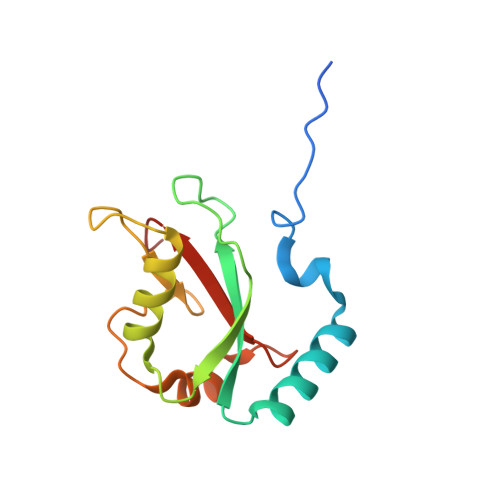Structural and functional analysis of the GABARAP interaction motif (GIM).
Rogov, V.V., Stolz, A., Ravichandran, A.C., Rios-Szwed, D.O., Suzuki, H., Kniss, A., Lohr, F., Wakatsuki, S., Dotsch, V., Dikic, I., Dobson, R.C., McEwan, D.G.(2017) EMBO Rep 18: 1382-1396
- PubMed: 28655748
- DOI: https://doi.org/10.15252/embr.201643587
- Primary Citation of Related Structures:
5DPR, 5DPS, 5DPT, 5DPW - PubMed Abstract:
Through the canonical LC3 interaction motif (LIR), [W/F/Y]-X 1 -X 2 -[I/L/V], protein complexes are recruited to autophagosomes to perform their functions as either autophagy adaptors or receptors. How these adaptors/receptors selectively interact with either LC3 or GABARAP families remains unclear. Herein, we determine the range of selectivity of 30 known core LIR motifs towards individual LC3s and GABARAPs. From these, we define a G ABARAP I nteraction M otif (GIM) sequence ([W/F]-[V/I]-X 2 -V) that the adaptor protein PLEKHM1 tightly conforms to. Using biophysical and structural approaches, we show that the PLEKHM1-LIR is indeed 11-fold more specific for GABARAP than LC3B. Selective mutation of the X 1 and X 2 positions either completely abolished the interaction with all LC3 and GABARAPs or increased PLEKHM1-GIM selectivity 20-fold towards LC3B. Finally, we show that conversion of p62/SQSTM1, FUNDC1 and FIP200 LIRs into our newly defined GIM, by introducing two valine residues, enhances their interaction with endogenous GABARAP over LC3B. The identification of a GABARAP-specific interaction motif will aid the identification and characterization of the expanding array of autophagy receptor and adaptor proteins and their in vivo functions.
- Institute of Biophysical Chemistry and Center for Biomolecular Magnetic Resonance, Goethe University, Frankfurt am Main, Germany.
Organizational Affiliation:
















